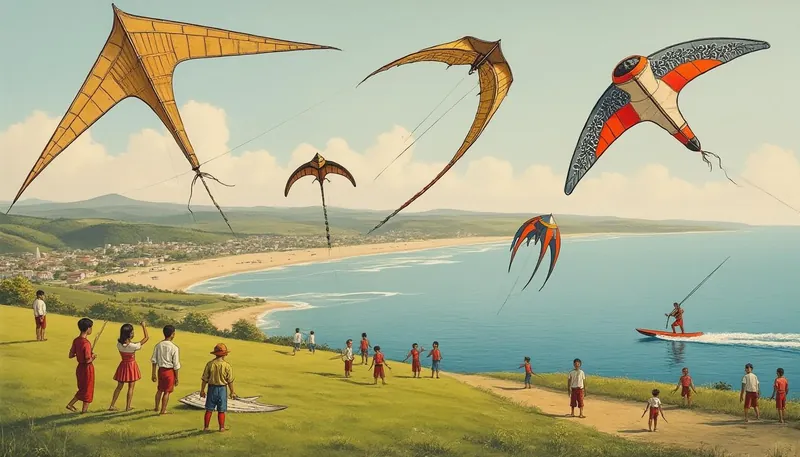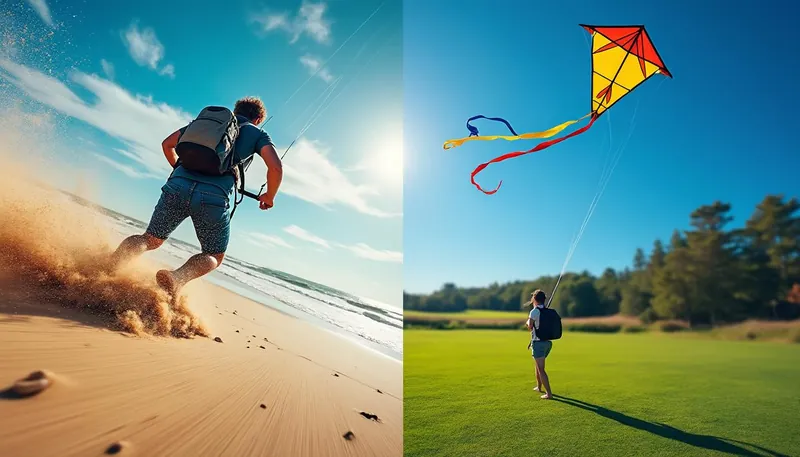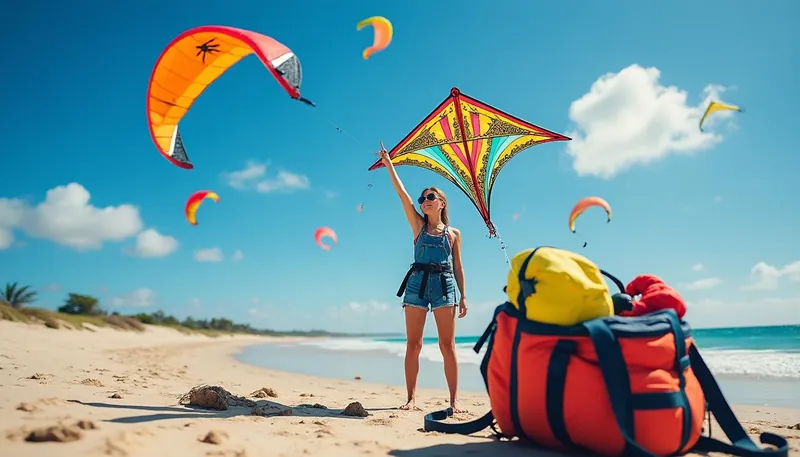When we think of kites, many of us envision colorful, soaring creations dancing in the sky, providing a sense of peace and recreation. However, the world of kiting expands far beyond this simple picture, diving deep into thrilling and extreme experiences known as traction kiting. This article explores the intricacies of traction kiting and contrasts it with the more traditional style of kite flying. We’ll navigate the different types of kites, discuss how they interact with wind and equipment, and touch on the evolution of these sports over time.
Traction kiting has made waves in extreme sports since the 1990s, evolving from mere recreational use to becoming a serious powerhouse in outdoor adventures. Unlike regular kite flying that focuses primarily on relaxation, traction kiting is all about using the kite’s pull to engage in activities like kitesurfing, kiteboarding, and kite buggying. The thrill comes from the power of the wind, allowing users to ride boards, buggies, or even skis while being pulled along. It’s a dynamic interaction that demands not only skill but a thorough understanding of the equipment involved. Think of the wind not just as a gentle breeze, but as a force that will propel you to exhilarating speeds!
The Anatomy of Kites: Traction vs. Traditional
Understanding the anatomy of kites is essential when differentiating traction kites from traditional kites. While traditional kites serve the primary purpose of flying for joy, traction kites are crafted to harness the wind’s strength effectively. The design and materials play a crucial role in this functionality.
Types of Kites
In the world of traction kiting, we mainly see two types of kites: foil kites and leading edge inflatable (LEI) kites. Here’s a breakdown of each:
- 🪁 Foil Kites: These kites are designed with multiple cells and rely on the lift generated by their aerodynamic shape. The air enters through open cells, giving them structure and allowing them to perform efficiently in various wind conditions. The ram-air foil is a common variant preferred by many advanced users.
- 🪁 Leading Edge Inflatable (LEI) Kites: These kites boast a tubular leading edge that is inflated before use. Their design is particularly favored in kitesurfing because they maintain their shape when wet, allowing for smooth water relaunch.
Table 1 below highlights the key differences between traction kites and traditional ones:
| Type of Kite | Primary Purpose | Popular Uses | Care and Maintenance |
|---|---|---|---|
| Traditional Kites | Recreational Flying | Family outings, Festivals | Easier to maintain; generally fabric with simple structures |
| Traction Kites | Wind Power Generation | Kitesurfing, Kite Buggying | Requires careful storage and repair due to complex materials and higher tension |
This distinct design and purpose determine how each kite operates in the wind, as well as the skills needed to navigate them. While traditional kites float gracefully, traction kites can pull a person with considerable force, bringing about a whole new level of excitement!

Equipment and Control Systems
Control systems are vital in differentiating traction kiting from regular kite flying. Traction kites typically utilize a series of lines, often ranging from two to five, with bars or handles that give the user better manipulation over the kite. This contrasts with traditional kites, which might only require a basic string and spool setup.
Control Mechanisms
Many traction kites require more intricate control systems for effective maneuvering:
- 🛠️ Fixed Bridle Kites: These have set angles of attack and can be adjusted slightly when on the ground, but not while airborne. They offer stable flying conditions, but lack some versatility.
- 🛠️ Depowerable Kites: These are ideal for kitesurfers as they allow the user to change the angle of attack mid-flight. By pulling or pushing the control bar, the flyer can increase or reduce power effectively. Safety is also a priority as these systems often come with mechanisms to prevent loss of control.
Understanding these control systems is crucial for beginners aiming to advance into traction kiting. An introduction to power kites should start with principles of control, safety measures, and practice in mild winds before moving on to exciting conditions.
Evolution of Traction Kiting
The origins of traction kiting can be traced back to the 1820s when innovators like George Pocock began experimenting with large kites to propel carts and ships. Fast forward to the late 20th century, advancements in materials like Kevlar and Spectra saw significant progress in kite designs, enhancing their control and efficiency.
Key Milestones
Here are a few crucial events that shaped the path of traction kiting:
- 🔍 In 1978, the « FlexiFoil » kite powered a Tornado catamaran to speeds exceeding 40 km/h.
- 🔍 The first real traction kiting patent was by Gijsbertus Adrianus Panhuise in 1977, laying the groundwork for modern kitesurfing.
- 🔍 In the 1990s, entrepreneurship boomed with brands like Peter Lynn, Naish, and Flexifoil leading the charge in developing powerful kites.
The innovative advancements in kite design have allowed for challenging sports like kite surfboarding, landboarding, and other extreme activities to emerge. Each step taken through history has cultivated a community of enthusiasts who continue to push the limits of speed and thrill.

Tackling Safety in Traction Kiting
Entering the world of traction kiting is exhilarating but can be risky. Safety systems have evolved over the years alongside kite developments, and understanding them is paramount for each user. Unlike traditional kite flying, where the most common concerns revolve around avoiding tangles or miscommunication, traction kiting has unique safety protocols.
Safety Systems and Protocols
Modern traction kites embrace several safety features designed to protect the user:
- 🛡️ Kite Killers: These are wrist straps that, when released, allow the kite to go slack and reduce its power instantly.
- 🛡️ 5th Line Release Systems: Often utilized in depowerable kites, these prevent the kite from flying away uncontrollable, ensuring safety during emergencies.
- 🛡️ Landing Techniques: Recognizing how to safely land your kite reduces the risk of accidents, especially in strong winds.
Each traction kiting experience should incorporate proper education on safety protocols, alongside hands-on training with experienced individuals. This commitment to safety helps build a vibrant and informed kiting community.
This and That: Key Differences Summarized
There are clear distinctions between traction kiting and traditional kite flying, impacting everything from the experience to the equipment. While both elements share the same joyful spirit, they cater to different adventures. The summarized differences may offer someone new to the sport a clearer perspective:
| Aspect | Traditional Kite Flying | Traction Kiting |
|---|---|---|
| Purpose | Recreational enjoyment | Wind propulsion techniques |
| Equipment | Simpler designs | Complex control systems |
| Control | Easy string and spool | Multiple-line systems with bars/handles |
| Safety | Basic precautions | Advanced safety systems in place |
What are the best brands for traction kites?
Popular brands include Ozone, Slingshot, and Cabrinha. Each brand offers a range of kites tailored for different conditions and maneuvers.
Can beginners start with traction kiting?
Yes, but proper training is essential. Beginners should start with a trainer kite and progress to larger kites under supervision.
What activities can I do with a traction kite?
Activities include kitesurfing, kite buggying, and kite skiing. Each offers a unique thrill and utilizes the kite’s powerful pull.
How do I maintain a traction kite?
Regularly inspect your kite for wear and tear, including lines and fittings. Clean the fabric and ensure it’s stored properly to avoid damage.
Are there any competitions for traction kiting?
Yes, there are numerous competitions globally, including kiteboarding events that test speed, technique, and styles.


